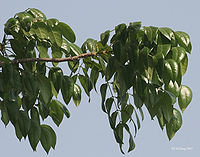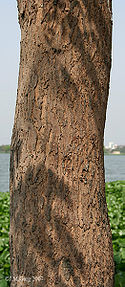- Swietenia mahagoni
-
Swietenia mahagoni 
Cultivated tree, India Conservation status Scientific classification Kingdom: Plantae (unranked): Angiosperms (unranked): Eudicots (unranked): Rosids Order: Sapindales Family: Meliaceae Genus: Swietenia Species: S. mahagoni Binomial name Swietenia mahagoni
(L.) Jacq.Swietenia mahagoni, commonly known as the West Indian Mahogany, is a species of Swietenia native to southern Florida, USA, The Bahamas, Cuba, Jamaica, and Hispaniola.[2] It is the species from which the original mahogany wood was produced.[citation needed]
Swietenia mahagoni is listed as "Threatened" in the Preservation of Native Flora of Florida Act.[3] Its blossom is the national flower of the Dominican Republic.
Contents
Discovery
The earliest recorded use of S. mahagoni was in the year 1514. That date was carved into a rough-hewn cross placed at the beginning of the Catedral de Santa María la Menor in Santo Domingo, Dominican Republic. The cathedral was completed in 1540. It was richly ornamented with carved S. mahagoni woodwork that was still in almost perfect condition after more than 400 years in the tropics.[4] The Cathedral of Santo Domingo, completed about 1540, is the oldest church in the West Indies. Santo Domingo is the oldest European-founded city in the Western Hemisphere. Bartholomew Columbus, a brother of Christopher Columbus, founded it in 1496.[5] Other records refer to the use of mahogany between 1521 and 1540 when Spanish explorers employed the wood for making canoes and for ship repair work in the West Indies. The next major recorded use was in 1597 regarding repairs for Sir Walter Raleigh's ships in the West Indies. Its first use in Spain and England was for ship building and during the eighteenth century it was the chief wood employed in Europe for that purpose.[6] Mark Catesby's Natural History describes mahogany's excellence in that regard. "[Mahogany] has Properties for that Use excelling Oak, and all other Wood, viz. Durableness, resisting Gunshots, and burying the Shot without Splintering."[7] Clayton Dissinger Mell's monograph expanded use in ship construction. "It is particularly suited for planking, waterways, bulwarks, rails, skylights and companions, bitts, gangway ladders, and other deck work. With the later employment of iron, steel and teak in shipbuilding, mahogany became far more important as a furniture wood, though it is still preferred to any other wood for the framework of small sailing vessels. Large sailing vessels with mahogany framework were sold for enormous prices and manufactured into fine furniture."[6]
The Spanish explorers were quick to appreciate West Indies Mahogany's splendid properties and its early importation and use in cabinetwork is attested by the 16th Century date of some fine Spanish Renaissance remains.[8] Queen Elizabeth is said to have been interested in some mahogany brought by Sir Walter Raleigh after his return from Trinidad in 1595.[9] As far as mahogany use in furniture making, no headway was made in England against the domestic oak and walnut until the 18th Century.[8] The first use of S. mahagoni in the United Kingdom for cabinet work was in 1724.[6] Mahogany is the essential ingredient of the great 18th Century School, which Macquoid calls the Age of Mahogany. Not only the United Kingdom, but France, Spain and Italy have used the wood more or less continuously since that time. The Empire Period featured it extensively; The Federal Period (1780-1830) in American work is essentially a mahogany style.[8] Mell's paper of 1917 reminds us of the extensive use in his time but some of those uses have diminished. Then, mahogany was much used for the interior finish of railroad parlor cars, public buildings, hotels, and dwellings and for ofice fixtures. It also was used extensively for pianofortes, for astronomical and surveying instruments and for the cases of all sorts of delicate apparatus, such as scales, microscopes, and microtomes. The tonewood value of S. mahagoni is reflected in the employment of mahogany for modern musical instruments. It is sometimes utilized in the tops of some guitars as well as the back, sides and neck. It is not uncommon in older mandolins. It is also used for some kinds of electrical guitars such as the Les Paul Custom, Deluxe and Studio models. Three-ply laminations of mahogany, poplar and mahogany are found in top of the line drum shells. Mahogany is used for the wooden bars of marimbas.
Enter The Naturalists: In British North America, when George Washington was a teenager and Benjamin Franklin had yet to fly his kite to demonstrate that lightening is electricity, expert botanists from Europe were exploring and describing the flora of the Carolinas and Florida. Forty-two years before naturalist and illustrator John James Audubon was born, Volume Two of Mark Catesby's folio sized natural history was published.[7] Catesby's hand-colored plate, 25 cm horizontal and 35 cm vertical (ca. 10x14 inches), of the mahogany tree, along with a description in English and French (not Latin as many might expect), was the basis for Linnaeus using his new binomial nomenclature to name it. Linnaeus' description was published in 1758 as Cedrela mahagoni.[10] Two years later Nikolaus Joseph von Jacquin reclassifed it and placed the West Indies Mahagony Tree into his newly created genus, Swietenia.[11] His classification still stands. However, 1758 was more than 200 years after mahogany was well-known to the lumber and woodworking trades.
Characteristics
Swietenia mahagoni is a medium-sized semi-evergreen tree growing to 30–35 metres (98–115 ft) tall. The leaves are pinnate, 12–25 centimetres (4.7–9.8 in) long, with four to eight leaflets, each leaflet 5–6 centimetres (2.0–2.4 in) long and 2–3 centimetres (0.79–1.2 in) broad; there is no terminal leaflet. The flowers are small, produced in panicles. The fruit is a woody capsule 5–10 centimetres (2.0–3.9 in) long and 3–6 centimetres (1.2–2.4 in) broad, containing numerous winged seeds.[2]
The bark in younger specimens is smooth and grayish, becoming darker and furrowed with age. In the U.S. mahoganies are semi-deciduous, losing all or most of their leaves over winter or shedding at the flush of new growth in spring. New leaves emerge blood red to pinkish, quickly becoming a bright, light green and darkening as they mature.
In the Florida Keys and south Florida, the species grows at the northern extent of its range, with individuals reaching 10–15 metres (33–49 ft) tall.
Cultivation and uses
Supplies have now become very rare due to over-harvesting, and most mahogany marketed now comes from other related species, often with faster growth but lower wood quality.[2]
It is also grown as an ornamental tree in subtropical and tropical regions.
U.S. Federal Experimental Forest
Since 1954 the United States government has owned and maintained a 147 acre observation plot of secondary growth S. mahagoni at Estate Thomas on St. Croix, United States Virgin Islands. It is managed jointly by the International Institute of Tropical Forestry with an adjoining privately owned tree farm at Estate Bellevue which belongs to the testamentary estate of Dr. Richard Marshall Bond a biologist who supervised the establishment of the federal tree farm at Estate Thomas.
Legal Protection
West Indies Mahogany is native to southern Florida; therefore an umbrella of state, federal and international conservation laws cover it. The other two species of Swietenia are also tonewoods used in the making of musical instruments. In addition to furniture and other woodwork, boxes and cases for mechanisms and similar valuables have a long history of being made of Swietenia.
The US Lacey Act of 1900: One of the provisions of the Lacey Act is that it requires a documented chain of possession for anything sold in USA. The Convention on International Trade in Endangered Species of Wild Fauna and Flora (CITES) lists S. mahagoni in Appendix II (only saw-logs, sawn wood and veneers). The International Union for Conservation of Nature (IUCN) classifies S. mahagoni as Endangered.[1] S. mahagoni is also listed as "Threatened" in the Preservation of Native Flora of Florida Act.
References
- ^ a b IUCN Red List: Swietenia mahagoni
- ^ a b c DANIDA Factsheet: Swietenia mahagoni
- ^ http://florida.plantatlas.usf.edu/Plant.aspx?id=3577
- ^ Lamb, F. Bruce. Mahogany of Tropical America Its Ecology and Management. The University of Michigan Press, Ann Arbor. p. 10. 1966
- ^ The World Book Encyclopedia Vol. 17. p. 117. 2011.
- ^ a b c Mell, C.D. True Mahogany US Dept. of Agriculture Bulletin No. 474. Professional Pager, February 9, 1917. Washington, D.C.
- ^ a b Catesby, Mark: Natural History of Carolina, Florida and the Bahama Islands. Volume 2, Plate 80 (illustration), text page 81. English and French. 1754.
- ^ a b c Aronson, Joseph. The New Encyclopedia of Furniture. Crown Publishers, Inc. New York. 1967.
- ^ Rolf, R.A. The True Mahoganies. Bulletin of Miscellaneous Information. Vol. No. 4. 1919. p. 202. Kew Gardens. England.
- ^ Linnaeus, Carolus: Systema Natura 10,2: p. 940. 1758.
- ^ Jacquin, N.J.: Enumeratio systematica planetarium, quas in insulis Caribaeis vicinaque Americes continente detexit novas, aut jam cognitas emendavit (1760).
External links
Categories:- IUCN Red List endangered species
- Swietenia
- Trees of Florida
- Trees of the Bahamas
- Trees of Cuba
- Trees of Hispaniola
- Trees of Jamaica
- Endangered flora of the United States
- Endangered plants
Wikimedia Foundation. 2010.



